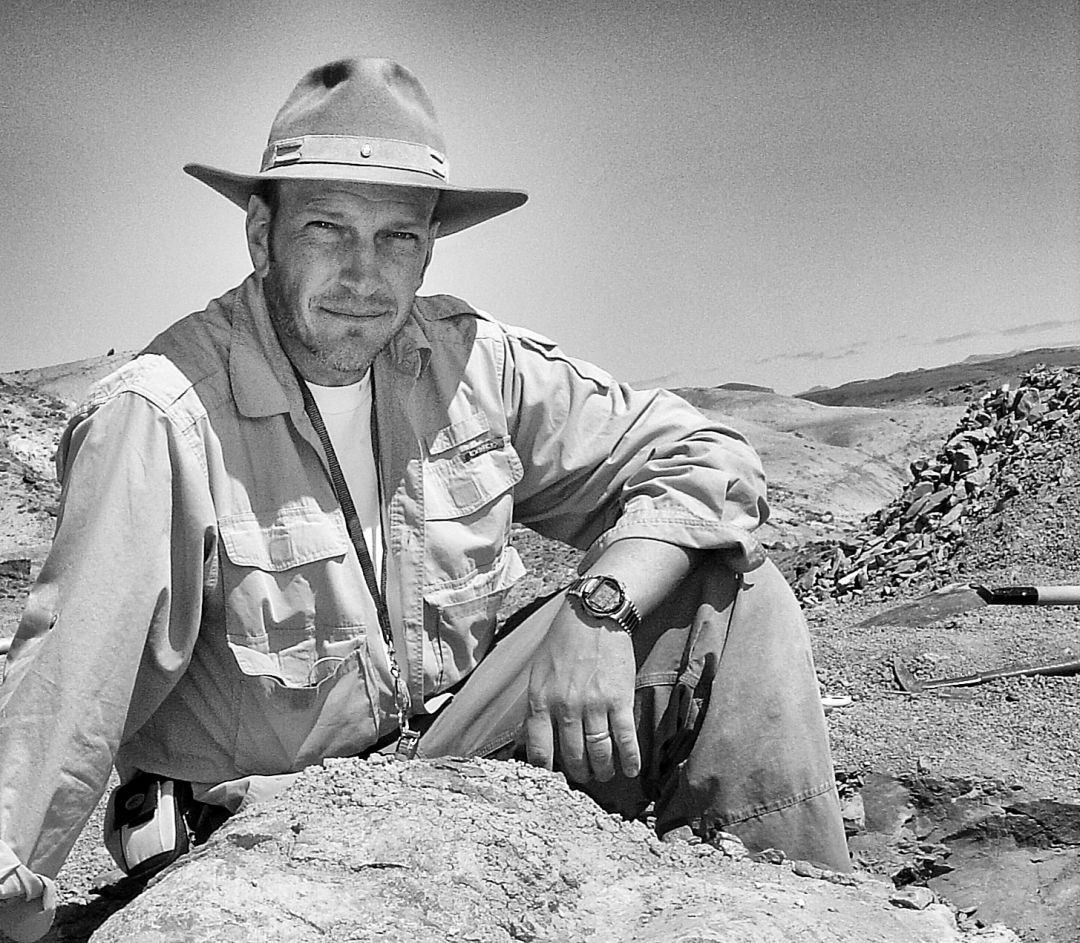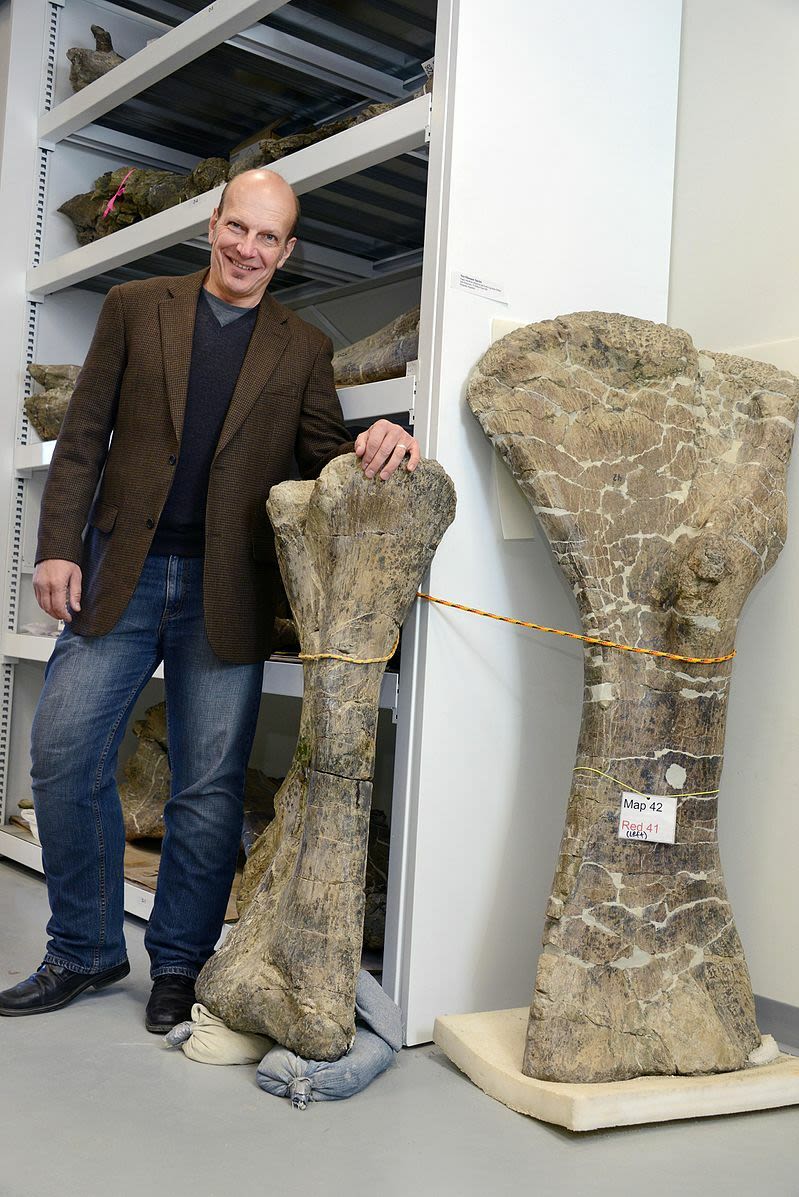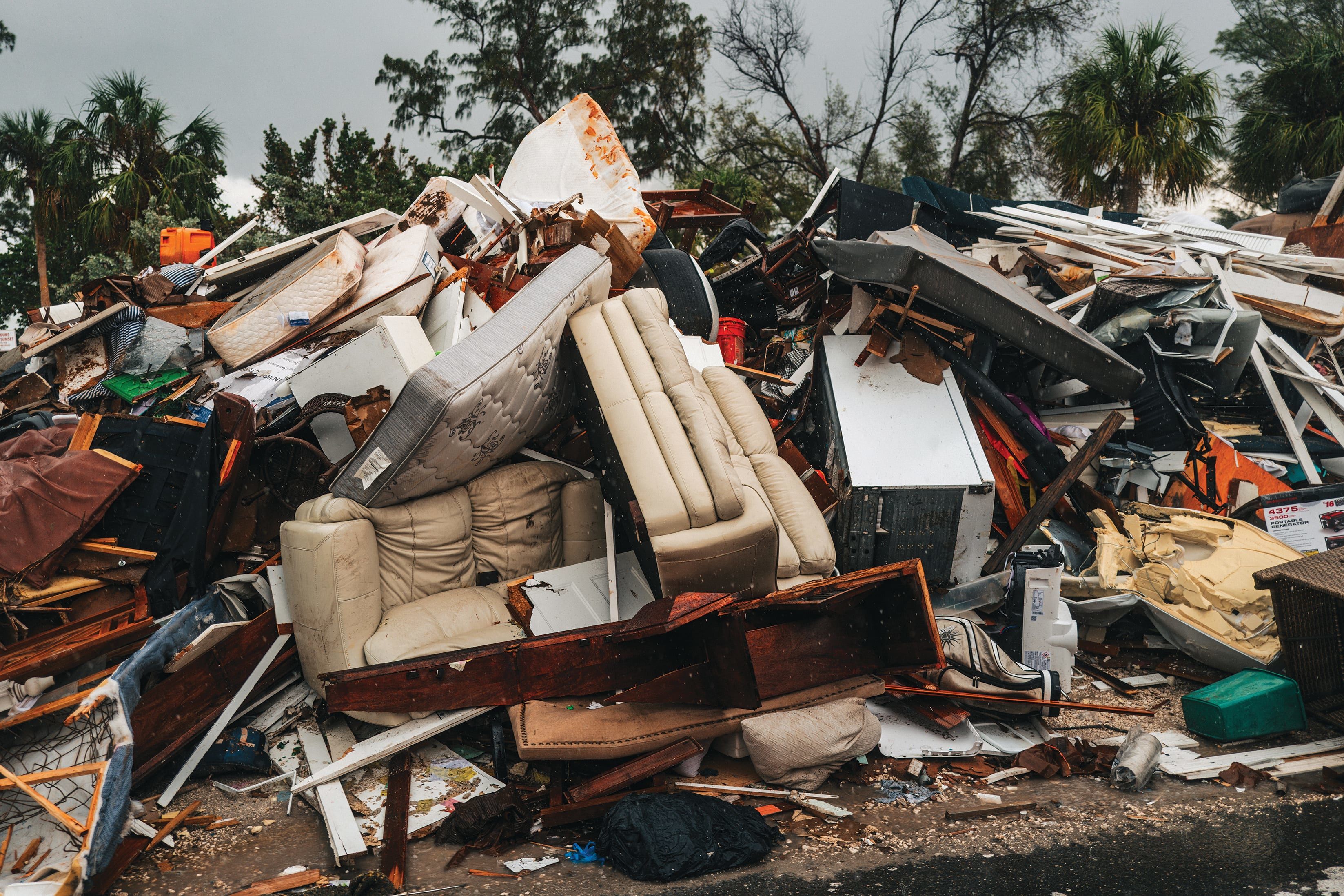World-Famous Paleontologist Kenneth Lacovara Will Speak at Sarasota Climate Conference

Kenneth Lacovara in Patagonia with the femur of Dreadnoughtus schrani in 2016.
Image: Via Wikimedia Commons
The Climate Adaptation Center's annual Climate Forecast Conference has taken on a new level of gravitas after Hurricanes Debby, Helene and Milton tore through our area, revealing a confluence of vulnerabilities in our built environment and generating a wave of destruction that communities are still reeling from.
Even so, the conference won’t be all gloom and doom.
“How Climate Warming Is Reshaping Florida’s Ecosystems” is the title for this year’s event, which will take place on Thursday, Nov. 13, at the University of South Florida Sarasota-Manatee.
“The climate we’re having now is not the climate of the '90s,” says Bob Bunting, the chief executive officer and chairman of the Climate Adaptation Center. “We can do better shifting from reaction to pro-action and from threat to opportunity, but that will require a shift in how we do things.”
Topics for this year's conference include information about what’s changing in Florida’s ecosystems; how biodiversity loss affects everything from agriculture to tourism; innovative adaptation and resilience strategies; and the opportunity to connect with leaders shaping the future of Florida’s environment.
Bunting's method for choosing the experts and speakers for the conference is intentional, and there is one returning speaker who might seem a surprising person to hear from at a climate conference: Dr. Kenneth Lacovara, a dinosaur paleontologist and the director and founding dean of Rowan University’s School of Earth & Environment in New Jersey. He'll be the first speaker of the day.
Lacovara looks like a real-life Indiana Jones (without the whip), and he laughs in response to the comparison, but he concedes that Jones’ character was based on the dinosaur paleontologist Roy Chapman Andrews, who was a household name in the early 20th century. (It was mostly his look that inspired the character, who was an archaeologist. Andrews was known for carrying a whip and ranger hat.)
"A couple of weeks ago, I was up in The Explorer’s Club, where I’m a member in New York, and they had just gotten Roy Chapman’s whip back from restoration," says Lacovara. "I held it in my hands. It’s the real Indiana Jones' whip.”
Lacovara moves from awesomely casual mentions of The Explorer’s Club—whose members have included the Apollo astronauts, Chapman, Jane Goodall and Neil deGrasse Tyson, to name a few—to deeply sobering descriptions of the climate crisis based on a perspective of geological time.
“If you only focus on the part of the record which is historical," he says, "it’s almost nothing compared to Earth’s history. If you were to divide the 4.5-billion-year history into a 1,000-page book, our distant ancestors, Australopithecus [think: Lucy], appear on the last page. And our species and all of civilization would be on the last line of that page in the book. If you really wanted to understand the book, you wouldn’t just read the last line of the book."
Lacovara's straightforward wit comes through even on the taxonomic record. When he and his team uncovered the massive bones of an 85-foot dinosaur in the arid badlands of Patagonia, he called the newly discovered species Dreadnoughtus, which means “fears nothing."
“I think it’s time that herbivores get their due for being the toughest creatures in an environment," he said of the name at the time.
The dinosaur was so large it took Lacovara and his team four austral summers to fully excavate the bones. He has spent nearly two years of his life living in a tent, through field seasons lasting two to three months at a time. At excavation sites, he says, every morning he would wake up and "break rocks and see things no human has ever seen before with things you can buy at a hardware store."
He describes being miles away from any electric grid in Patagonia, with most of Dreadnoughtus' skeleton exposed by that point, when he noticed a fuzzy dot in the night sky changing position each evening. One night, when his crew was already back at camp making dinner, he saw a giant tail form on that dot. It was dark, and he was sitting drinking a spot of whiskey in front of the Dreadnoughtus quarry looking out at the world's largest dinosaur laid out on the ground in front of him with a giant comet hanging overhead. "I thought, 'I will never have a more sublime moment than this,'" says Lacovara.

Kenneth Lacovara and the fibula (center) and humerus (right) of Dreadnoughtus schrani.
Image: Via Wikimedia Commons
But why is he returning to a climate conference instead of digging for dinosaur bones in a far-off desert?
“You just realize it’s getting worse and it’s getting worse fast, and humans aren’t doing enough to solve it," he says. "So now, I’m really devoting a large part—maybe a majority—of the rest of my career to this. Would I rather be in a desert digging up some dinosaur somewhere? Yeah, definitely. But I feel compelled to do this. I think everybody who can needs to, because our posterity will look back at us at this moment and think, ‘How did they do anything else? How did they ever talk about anything else? How did they spend money on anything else when the planet was on fire?’”
Lacovara is not just talking at climate conferences, he's putting together The Jean and Ric Edelman Fossil Park and Museum, a 44,000-square-foot museum at Rowan that will walk visitors through the Earth's ages. It will begin with the dinosaurs, continue through the fifth extinction that killed the dinosaurs, and move on to the Anthropocene hall and into the sixth extinction where visitors will see the Dodo bird and the Tasmanian tiger. Visitors will also see an awesome display of what inspired Lacovara to dive into science in the first place: the Apollo missions and an experience of what an Earthrise looks like from the moon. The final space is the gallery of hope, where different objects can be illuminated along with a projection on the wall. Following that, kiosks will be set up that can help visitors connect with an organization that they care about.
"One of the things that gives humans hope is to have agency," Lacovara says. "Whether you're doing something small or big, the act of doing is an act that generates hope."
There will also be an area where kids can dig around and collect fossils for themselves.
"I do not have evidence-based hope," says Lacovara. "For me, I think, hope is a choice, but it’s not empirically derived. I just choose to have hope because I want to live a hopeful life and I’m afraid of what will happen if I didn’t choose hope. But I’m not using my science brain at that point."
Lacovara is a scientist first and foremost, but he's also a human being coping with an awareness of the fragility of life on Earth.
“Being a paleontologist—a geologist—provides deep time perspective,” he says. Indeed, when he refers to the recent past, he means the last 2 million years. His conversation slips smoothly between deep time and the present, as you'd expect for someone who can look at rocks and see stories that reach back millions of years.
Lacovara says he is also working with Colossal, a Dallas-based company using the DNA gene-editing tool CRISPR, to try to bring back the woolly mammoth, the marsupial wolf (Thylacine) "and some other things that I can't tell you about yet." He points out that all the species they are focusing on were pushed out by humans, and that mammoths existed alongside humans.
"We're not talking about Jurassic Park here, we're talking about mammals that belong in this world," he says. "Three thousand years ago is a world that has written stories, beer and pyramids." The same techniques that they use to revive the woolly mammoth—which Lacovara calls a moonshot—can help to save species that are alive now but on the brink, even while he points out that it's not an answer to biodiversity crises. There's no silver bullet.
Lacovara is also a professor and is always thinking of analogies that can help his students understand. He extends another one to describe the perspective that deep time offers when considering our climate crisis.
“We don’t have, in the geological record, an example of things changing this fast on planet Earth except when that asteroid hit,” he says gravely, referring to the fifth extinction. “We’re that asteroid of our age. It’s the rate of change that matters. I used to ask my students, 'What would be the effect on you if you drank a six-pack of beer over the next 10 years? Nothing. How about over the next half hour? Big effect.' What we’re doing to the climate and biodiversity right now is happening geologically instantaneously, so if it happens over 200 years or over three days, like when the asteroid hit, geologically that’s the same. They’re both instant.”
Carl Sagan was a strong influence on Lacovara from a very young age, and he’s now friends with Sagan’s widow, Ann Druyan. For Lacovara, Sagan’s work sparked an interest in science itself, not astronomy. But it should come as no surprise that Sagan’s work—famous for igniting the phrase "pale blue dot" when Voyager 1, after capturing images of the outer reaches of our solar system, turned back to capture an image of the Earth—would send Lacovara to focus the lens of his work back to Earth, the deeper layers of its skin and into its deep past.
When Carl Sagan presented the Voyager’s image of Earth in a public broadcast, he pointed to a tiny blue dot on the screen encapsulated in giant a ray of sunlight and said, “That's home. That's us. On it, everyone you love, everyone you know, everyone you ever heard of … every saint and sinner in the history of our species lived there—on a mote of dust suspended in a sunbeam.”
Lacovara appears to have taken that to heart.
"Sorry, Elon Musk," he says, with a frustrated chuckle, "but there's no planet B."
"I really hope we explore Mars, but we're not going to put a city of a million people on Mars," he continues. "We have an entire continent on Earth that we don't even have a breeding population of humans on. There's a continent on Earth that has niceties like air and water. We have Antarctica. Compared to Mars, Antarctica is a tropical paradise."
Of course, here in Sarasota, life feels wonderfully liveable at present. It can be hard to remember that this global problem has some very real local impacts—until homes are gone, roads are flooded and the power's out after a hurricane in the height of the heat season, reminding us of the increasing tyranny of water.
Locally, the global heating effect will produce more storms like Hurricanes Helene, Debby and Milton, likely with hotter and more humid days following them. And Bunting says that if "a heat-wave of 95 to 105 degrees occurs with 70 percent humidity in the Sarasota area, a lot of people will have survived the hurricane, but a lot of people will then die from the heat.”
A recent First Street Foundation study released a map projection last fall that shows our region will endure summers with temperatures reaching more than 107 degrees Fahrenheit for 29 days out of the year. This year is expected to have just seven of those sweltering days; 30 years ago, there was only one day that broke that mark each year.
Bunting also points to how our shifting climate will affect the quality of our water, since warmer temperatures can breed more red tide events, which in turn can impact the biodiversity of marine life that keeps our waters clear and beautiful—marine life that we are already pressuring.
"By the time you're experiencing it," he says, "it's almost too late to do anything about the issue. It will change our whole way of life."
The 2025 CAC Florida Climate Conference will take place on Thursday, Nov. 13, 2025. Ken Lacovara is the director and founding dean of Rowan University's School of Earth & Environment. His book Why Dinosaurs Matter is available now.



